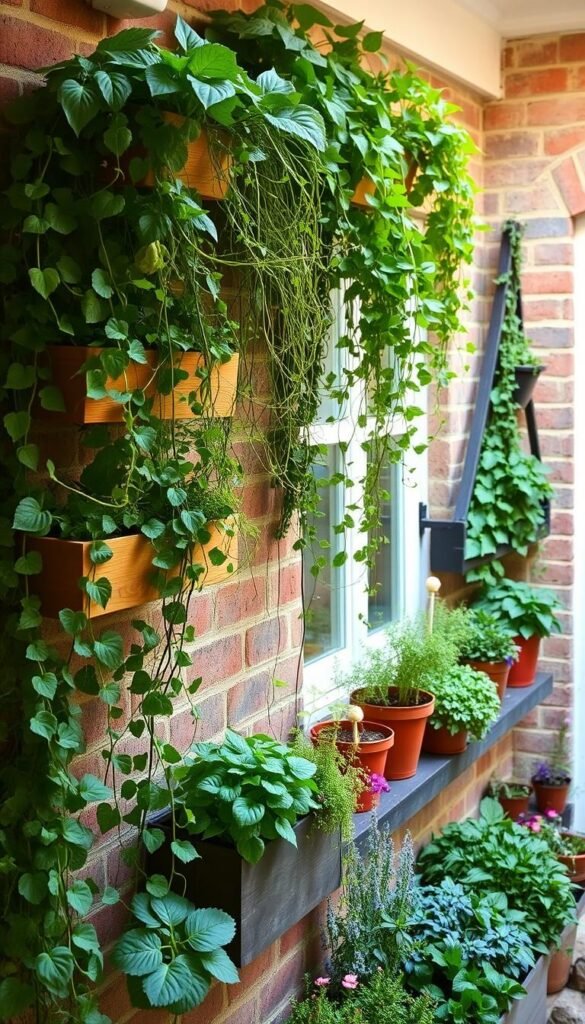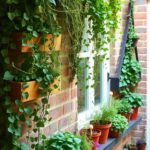Ever feel like your outdoor area is too cramped for a thriving green retreat? Think again! With creative strategies, even the smallest corners can burst with life. Vertical gardening unlocks possibilities you might’ve overlooked, turning walls, fences, and empty surfaces into lush, productive zones.
Why limit yourself to ground-level planting? Hanging baskets, climbing vines, and tiered planters add layers of beauty while saving precious square footage. Studies show these setups reduce pest issues by 40% compared to traditional methods—plus, they’re perfect for herbs, flowers, or veggies.
You don’t need fancy tools to start. Repurposed items like wooden crates or gutters become charming plant homes. Pair them with vertical container gardening methods to grow 30% more basil or 25% extra herbs. It’s practical and eye-catching!
This guide dives into smart layouts that blend form and function. Discover how to balance light, water, and airflow for healthy plants. Whether you’re working with a balcony or a postage-stamp yard, you’ll learn to transform limitations into opportunities—one upward-bound planter at a time.
Embracing Vertical Gardening: A Modern Approach
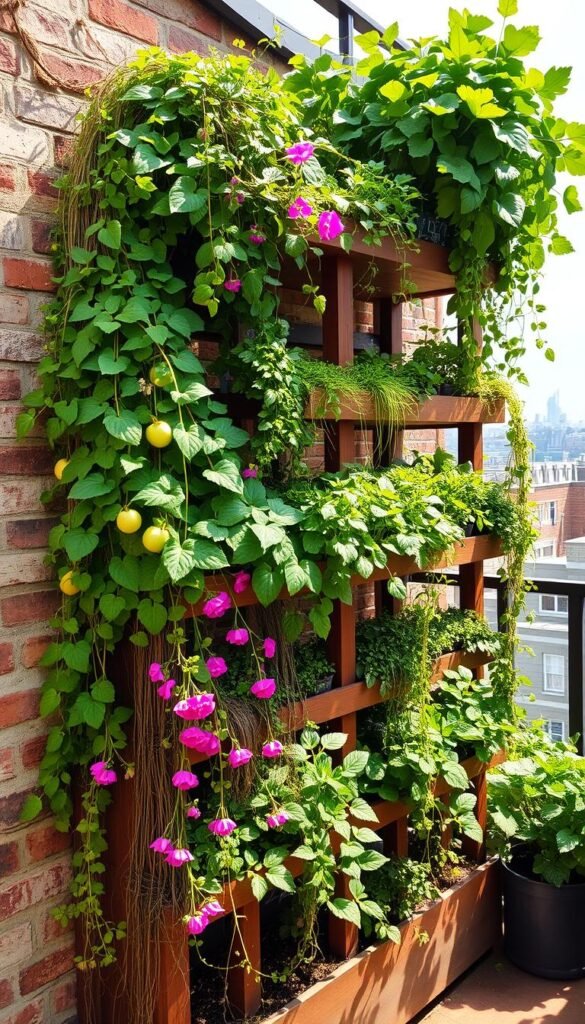
Vertical gardens aren’t just trendy—they’re transforming how we interact with limited areas. By growing upward instead of outward, you create living ecosystems that work smarter, not harder. This method breathes new life into urban settings and cozy patios alike.
Benefits of Vertical Planting
Vertical gardening does more than save space. Studies show these systems filter airborne toxins and dampen street noise by up to 40%. Imagine plucking fresh basil for dinner while your green wall cleans the air! Cool-toned plants like lavender or colorful blooms add depth, making tight spots feel expansive.
Sustainable and Space-Saving Tips
Here’s how to maximize efficiency:
- Use self-watering planters to cut water waste by 30%
- Mix edible and ornamental species for dual-purpose beauty
- Install modular panels that adapt to seasonal changes
One urban gardener grew 18 herb varieties on a 4-foot balcony screen. “It’s like having a spice rack that purifies the air,” they shared. With smart plant choices and recycled materials, your vertical oasis becomes an eco-powerhouse.
Tiny Cottage Garden Hacks: Clever Ways to Maximize Vertical Space
What if every bare surface could become a vibrant display of greenery? Three materials revolutionize how you use vertical surfaces: wooden pallets, PVC pipes, and wire mesh. Each offers unique benefits for creating lush, functional displays that blend charm with practicality.
Start by evaluating your walls, fences, and railings. A weathered pallet mounted horizontally becomes a rustic shelf for succulents or herbs. For narrow areas, vertical PVC pipe planters hold 6-8 vegetables thrive in vertical setups like cherry tomatoes. Wire grids let climbing nasturtiums create living curtains.
| Material | Best For | Tips |
|---|---|---|
| Wooden Pallets | Herbs & Flowers | Line with landscape fabric |
| PVC Pipes | Leafy Greens | Drill drainage holes every 4″ |
| Wire Mesh | Climbing Plants | Use zip ties for stability |
Layer these elements for depth. Place shallow-rooted plants like pansies in upper tiers, reserving deeper containers below for carrots or radishes. This approach triples growing areas while maintaining a cottage-style whimsy.
Proper planning ensures success. Follow vertical garden layouts that group plants by sunlight needs. South-facing walls suit sun-loving strawberries, while ferns flourish on shaded eastern exposures. Rotate seasonal varieties to keep your living wall thriving year-round.
Creative Hanging Baskets and Container Ideas
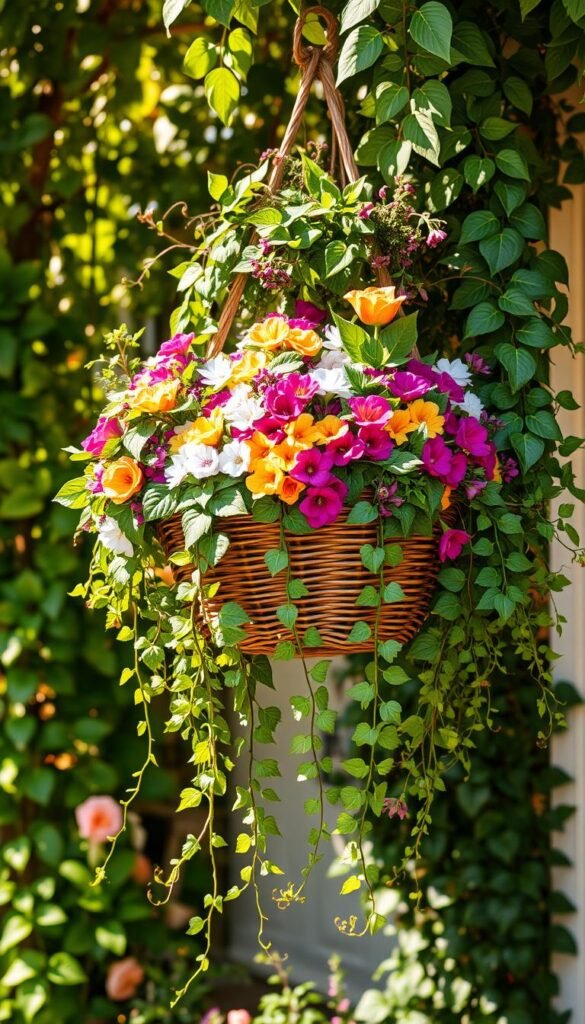
Elevate your greenery game with containers that do double duty—beauty and function. The right hanging displays turn overlooked spaces into living art while boosting your harvest potential. Let’s explore how to pair practical needs with eye-catching designs.
Choosing the Right Pots and Baskets
Durability meets style in modern hanging solutions. Opt for lightweight resin baskets in humid climates or woven metal for rustic charm. Consider these factors:
- Coir liners retain moisture for thirsty herbs
- 12-16″ diameter baskets suit tomatoes
- Self-watering pots reduce daily upkeep
One urban gardener swapped heavy ceramics for recycled plastic planters: “My basil thrived, and my porch beams thanked me!” Always check weight limits—a filled 14″ basket can hit 15 pounds when watered.
Styling Tips for Visual Flow
Create rhythm by alternating heights and textures. Hang trailing ivy below compact pepper plants, or cluster pastel petunias beside bold red geraniums. For shaded walls, mix silver-dollar ferns with variegated pothos.
Pro tip: Use matching hooks or chains to unify mismatched containers. Stagger three baskets along a stair rail, or drape a vertical chain of succulents down a fence post. As one designer notes: “Repetition in color or shape makes chaos look intentional.”
Utilizing Recycled Materials and DIY Projects
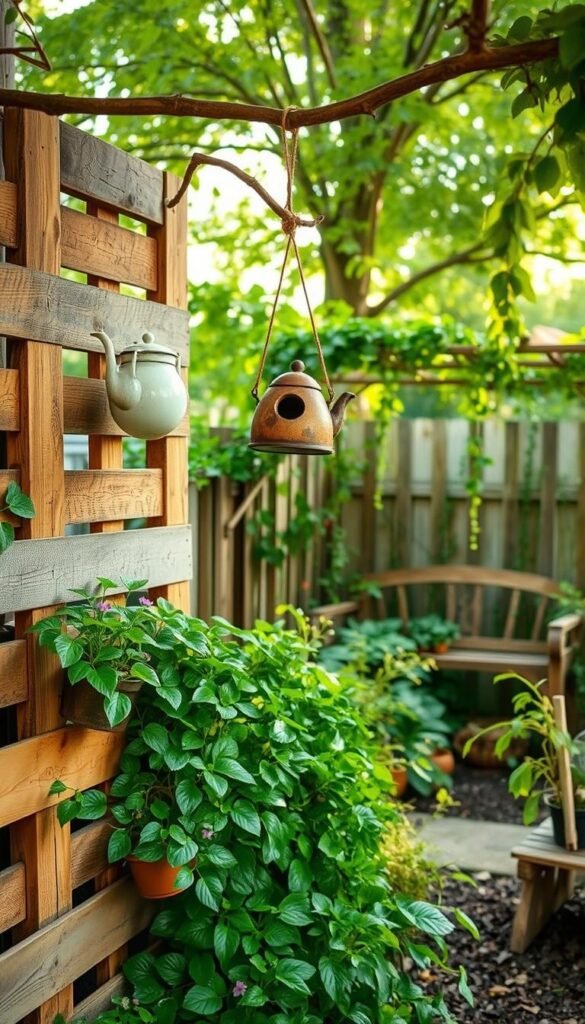
Turn trash into treasure with inventive upcycling strategies that merge eco-conscious living with lush greenery. Everyday items destined for landfills can become stunning focal points when reimagined as planting systems. Let’s explore how to breathe new life into forgotten objects while reducing waste.
Pallet Garden and Ladder Repurposing
Wooden pallets are gold mines for vertical planting. Secure one against a sunny wall, line its slats with landscape fabric, and fill with soil. This creates instant pockets for strawberries or trailing petunias. For herbs like thyme and oregano, space plants 6-8 inches apart.
Old ladders make perfect tiered displays. Try these setups:
- Paint a weathered ladder sage green for cottage charm
- Place terra-cotta pots on alternating rungs
- Use the top step for sun-loving succulents
Transforming Bottles and Other Reusables
Plastic bottles become self-watering planters when cut horizontally. Hang them with jute twine and plant mint or basil. For stability:
- Punch drainage holes in the bottom
- Layer pebbles beneath potting mix
- Group 3-5 bottles vertically for visual impact
One gardener transformed 12 wine bottles into a cascading herb wall: “My parsley grows twice as fast in these clear containers!” Always secure recycled materials properly—use wall anchors for heavy items and check structures monthly.
Building Vertical Structures for Maximum Impact
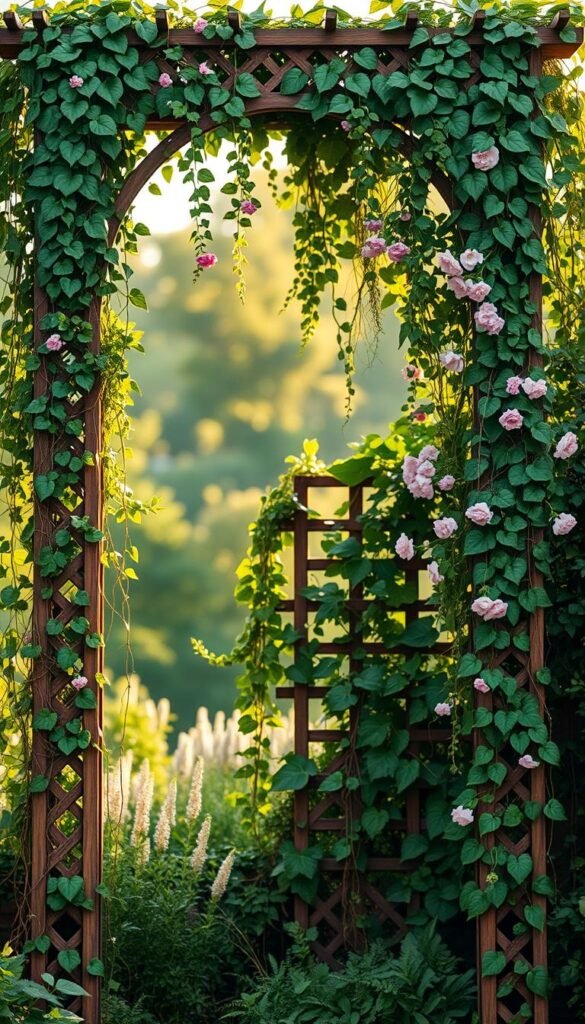
Transform your walls into living masterpieces with smart structural solutions. Thoughtful design turns basic supports into thriving ecosystems that marry form and function. Let’s explore how to craft systems that grow with your plants while enhancing your outdoor aesthetic.
Designing Trellis and Wire Mesh Systems
Trellises offer natural pathways for climbing vegetables like sugar snap peas. Build yours using rot-resistant cedar or powder-coated metal slats spaced 6-8 inches apart. For quick setups, attach galvanized wire mesh to any wall or fence—pole beans will spiral upward within weeks.
| Material | Best Plants | Installation Tip |
|---|---|---|
| Wood Trellis | Peas, Passionflower | Anchor with 12″ ground stakes |
| Wire Mesh | Cucumbers, Melons | Use UV-resistant zip ties |
| Bamboo Grid | Morning Glories, Beans | Seal joints with outdoor glue |
Innovative Pipe and Frame Solutions
Upgrade traditional supports with modular piping systems. PVC or copper pipes create sleek vertical garden frames perfect for strawberries or herbs. Try this setup:
- Cut 1″ pipes into 3-foot sections
- Connect with elbow joints to form squares
- Mount planters using adjustable clamps
“My DIY pipe frame holds 24 basil plants—it’s like a living spice rack!”
Balance beauty and durability by calculating weight loads. A 4×6-foot structure can support 50 pounds when properly braced. Pair flowering vines with edible plants for displays that nourish both eyes and appetite.
Innovative Indoor Vertical Gardening Techniques
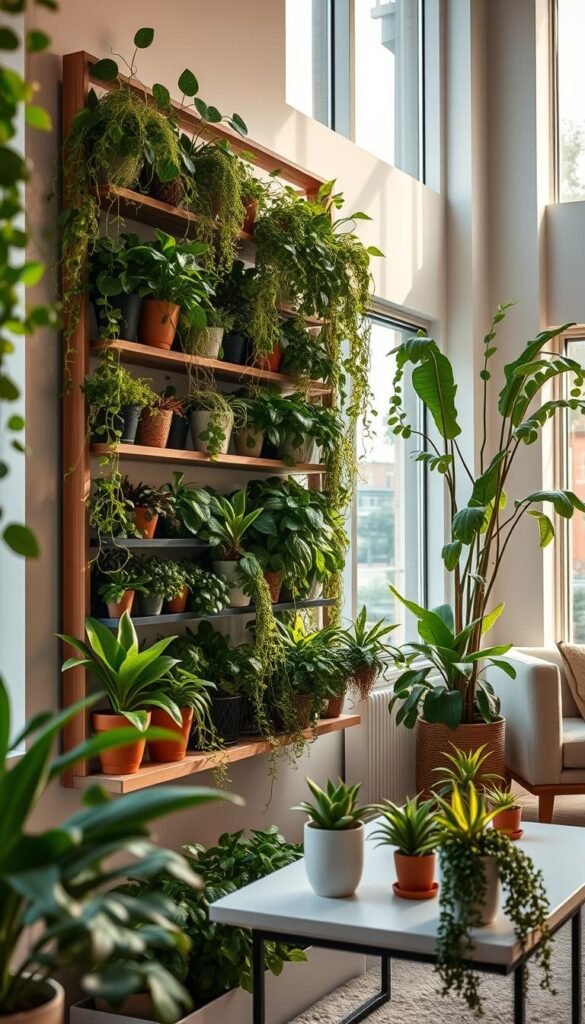
Who says your green thumb has to stay outdoors? Indoor vertical systems let you cultivate thriving greenery while enhancing your home’s air quality and style. These living installations work in apartments, offices, or any room craving natural vitality.
Creating Living Walls and Shelf Gardens
Living walls turn blank surfaces into breathing ecosystems. Start with a waterproof backing board, attach felt pockets for soil retention, and install drip irrigation. Boston ferns and pothos thrive here—their trailing vines create cascading effects while filtering airborne toxins.
For kitchens, try floating shelves with herb trios:
- Basil, thyme, and mint in south-facing windows
- Parsley and chives under LED grow lights
- Succulent arrangements above sinks
One New York homeowner transformed her studio using modular planting racks: “My rosemary grows faster indoors than on my old balcony!”
| Light Condition | Best Plants | Care Tip |
|---|---|---|
| Low Light | Snake Plant | Water every 3 weeks |
| Bright Indirect | Spider Plant | Mist leaves weekly |
| Direct Sun | Aloe Vera | Rotate daily |
Maintain your green wall with monthly fertilizer spikes and seasonal pruning. Group moisture-loving species near humidifiers, and place drought-tolerant varieties in drier areas. As one designer notes: “Your vertical garden should evolve with your space—swap plants like artwork!”
Optimizing Outdoor Spaces with Vertical Planters
Transform overlooked nooks into lush displays with vertical planters that work smarter, not harder. Wall-mounted systems and freestanding towers turn blank walls into thriving ecosystems. Hanging baskets shine here—mount them under eaves or along fence lines for cascading herbs or flowering annuals.
Choose materials suited to your climate. Powder-coated metal withstands coastal salt air, while resin planters resist cracking in frost-prone areas. For cottage charm, try woven baskets lined with coconut fiber. Always check weight limits—a filled 18″ planter can exceed 20 pounds!
| Planter Type | Best Use | Durability |
|---|---|---|
| Resin Wall Planters | Herbs & Annuals | 5+ Years |
| Galvanized Steel | Succulents | Rust-Resistant |
| Fabric Pockets | Leafy Greens | 3 Seasons |
Position planters where they’ll thrive. South-facing walls suit sun-loving strawberries, while ferns prosper in shaded corners. Leave 12″ clearance between stacked units for air circulation. One gardener reported: “My patio harvest doubled when I grouped planters by water needs.”
Rotate crops seasonally—swap summer basil for winter kale. Use drip trays in windy areas to maintain moisture. With smart placement and hardy materials, your outdoor area becomes a year-round green sanctuary.
Smart Planting Techniques for Year-Round Growth
Keep your planters productive through every season with strategic choices that deliver color, flavor, and texture. Focus on species that pull double duty—ornamental flowers that attract pollinators alongside kitchen-ready herbs and compact vegetables.
Selecting Herbs, Vegetables, and Flowers
Prioritize plants with extended performance. Basil and mint thrive in vertical setups, offering continuous harvests when trimmed regularly. For blooms, choose repeat-flowering varieties like Erysimum ‘Bowles’s Mauve’—its purple spikes last 9 months!
| Plant Type | Best Varieties | Harvest Period |
|---|---|---|
| Herbs | Greek Oregano, Lemon Thyme | April–October |
| Vegetables | Cherry Tomatoes, Dwarf Peppers | June–Frost |
| Flowers | Hardy Geraniums, Erigeron | May–November |
Long-Season Planting Strategies
Layer crops by maturity dates. Start with cool-weather lettuce in spring, then swap in heat-loving beans for summer. As one gardener notes:
“My vertical tower grows rosemary in winter and nasturtiums by July—it’s always working!”
Rotate plants every 60-90 days using seedlings. Pair shallow-rooted vegetables like spinach with deep-growing carrots to maximize soil use. This approach ensures fresh ingredients while keeping your display vibrant.
Design Principles for a Cohesive Garden Look
Want your compact outdoor space to feel both stylish and spacious? Strategic design choices create harmony while amplifying visual appeal. Focus on color coordination, repeated patterns, and smart furniture pairings to craft a polished yet welcoming atmosphere.
Using Color Schemes and Repetition
Cool-toned plants like lavender or blue salvias push boundaries outward, making your small garden appear larger. Pair them with warm accents—yellow marigolds or coral begonias—for balanced energy. Repeat these hues in cushions or ceramic pots to tie the space together.
Consistency matters. Use matching planters along walkways or echo wood textures in benches and trellises. This repetition guides the eye smoothly, as seen in creative outdoor decor that blends stone pathways with pebble-filled containers.
Balancing Planting with Furniture Elements
Choose furniture that complements—not competes with—your greenery. A sleek metal bistro set pairs well with airy ferns, while rustic wooden stools enhance cottage-style blooms. Leave breathing room: cluster three pots around a bench instead of crowding surfaces.
Multi-functional pieces shine here. Storage ottomans hold gardening tools, and foldable tables adapt to seasonal needs. By merging practicality with aesthetics, your garden design becomes a seamless extension of your living space.

